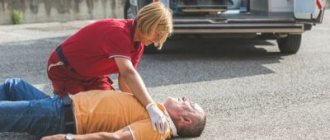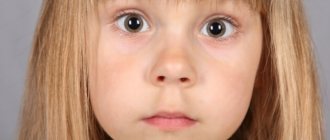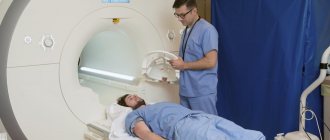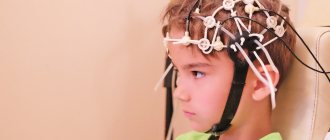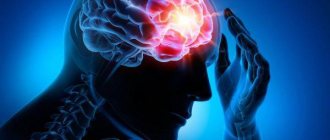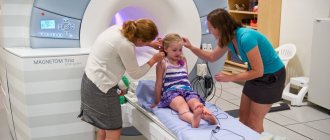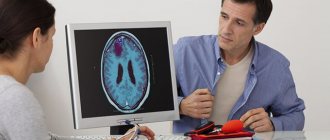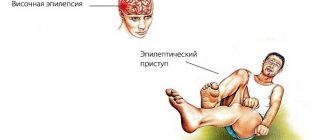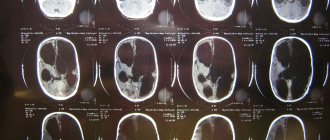Childhood absence epilepsy is one of the types of epilepsy that manifests itself in the form of non-convulsive symptoms (absence seizures). Most often diagnosed in preschool and school age, it is a genetic disease.
The child suffers from attacks in the form of instant stupor (freezing in a certain position for some time). Such attacks can be repeated up to several times a day. Many parents do not always pay attention to such absence seizures, considering this condition to be an individual characteristic of the child.
However, we must remember that timely diagnosis and treatment will help avoid worsening the condition in the future. Absence epilepsy is a type of nervous disorder and requires mandatory medical care. With proper therapy, you can count on a complete recovery.
Causes
Experts believe that the disease in children manifests itself due to congenital abnormalities in the structure of the brain. They arise mainly during intrauterine development. In more rare cases, the defect occurs due to damage to neurons in the later stages of fetal formation.
Among the pathologies that contribute to the development of this type of epilepsy are the following:
- Congenital defects of the nervous system;
- Dropsy of the brain;
- Underdevelopment of the skull.
There are other factors influencing the development of absence epilepsy, namely:
- Genetic predisposition;
- Immaturity of brain mechanisms responsible for excitation and inhibition;
- Endocrine disruptions;
- Disturbances in metabolic processes;
- Traumatic brain injuries;
- Intoxication due to poisoning or the development of an infectious pathology;
- Education in the brain;
- Constant physical and mental fatigue.
Classification of attacks
Absence seizures are usually classified according to the severity of the leading symptoms:
- Typical absence seizures occur without preliminary signs, the patient seems to turn to stone, his gaze is fixed on one point, and the movements made before this stop. Full mental state is restored in a few seconds.
- Atypical absence seizures are characterized by a gradual onset and end and a greater clinical picture. The patient may experience bending of the body, falling of objects from the hands, and automaticity in movements. A decrease in tone often leads to an unexpected fall of the body.
In turn, complex, atypical absence seizures are divided into several forms:
- Myoclonic absence seizures are short-term complete or partial loss of consciousness, accompanied by sharp, periodic tremors throughout the body. Myoclonus is usually bilateral and is most often detected on the face - the corners of the lips, eyelids, and muscles near the eyes twitch. An object in the hands during an attack falls out.
- Atonic absence seizures are characterized by a sharp weakening of muscle tone. This may be accompanied by a fall, after which the patient slowly gets up. Sometimes weakness occurs only in the neck muscles, causing the head to hang down on the chest. In rare cases, during such an attack, involuntary urination is detected.
- Akinetic absence is a complete loss of consciousness combined with immobility of the entire body. Often such absence seizures occur in children under the age of 9 years.
- Absence seizures with vegetative manifestations - in addition to loss of consciousness, this form is characterized by urinary incontinence, sharp enlargement of the pupils, and flushing of the facial skin.
Article on the topic: Which whitening toothpaste does its job better and more gently?
It is also customary to subdivide absence seizures by age:
- absence seizures in children are first recorded before the age of 7 years;
- Juvenile absence seizures are detected in adolescents aged 12-15 years.
Types of absence epilepsy in children
Childhood absence seizures are divided into 2 forms according to the time of onset of the first symptoms:
- Children's (from 2 to 8 years);
- Youth (from 8 years and older).
The nature of the attacks is as follows:
- Simple absence seizures (typical);
- Complex (atypical).
The first variety usually lasts no more than 10 seconds. An attack is characterized by freezing in one place and lack of response to external stimuli. After its completion, the child continues to go about his business as if nothing had happened.
Atypical absence seizures can last up to 20-30 seconds and differ from typical seizures in the following manifestations:
- Sudden movement of the body;
- Strange gestures;
- Constant licking of lips and adjusting clothes;
- Throwing the head back;
- Movement of the tongue.
In the most severe cases, in addition to the listed symptoms, atypical absence seizures also manifest themselves in the form of a sharp bending of the body backwards. At the same time, the baby can make movements with his hands to normalize balance, but sometimes falls occur. Such seizures are quite noticeable and patients often realize that clouding of consciousness has occurred.
What is characteristic of absence seizure?
Absence is an attack in which a person’s consciousness completely or partially does not respond to the reality around him.
Absence seizures are characterized by the fact that the attack lasts from several seconds to half a minute and is most often not noticed by others. The recovery process also occurs in a few seconds; usually the person continues to do what he was doing before losing consciousness.
At the time of an attack, autonomic disorders sometimes occur - pallor or redness of the skin.
Absence seizure can be characterized by three typical signs for this type :
- The attack lasts no more than a few seconds.
- There is no reaction to external stimuli.
- After an absence seizure, a person believes that everything was fine. That is, the sick person does not remember the attack itself.
A characteristic feature of this type of blackout can be called a large number of absence seizures in both children and adults. Consciousness can turn off from ten to hundreds of times a day.
Children's form of pathology
Absence seizures in children begin to appear at the age of 2 and are a benign type of epilepsy. It has a fairly positive prognosis, but for this you need to undergo diagnosis in time and follow the doctor’s instructions. In most cases, treatment with medications with an anticonvulsant effect lasts about 5-6 years and ends with complete elimination of the problem. Sometimes epilepsy still persists, but a stable remission is achieved, in which repeated attacks occur no earlier than 20 years. It is possible to achieve such results, but for this you need to know how the pathological process manifests itself.
Treatment approaches
The main goal of therapy is to reduce the number of epileptic paroxysms and prevent the progression of the disease. Treatment of absence epilepsy is based on the use of anticonvulsants - ethosuximide and drugs based on valproic acid. If the child or teen does not tolerate these medications well, the doctor may switch to a benzodiazepine (Carbamazepine) or lamotrigine. If epilepsy persists for a long time and treatment is low, complex therapy using combinations of anticonvulsants is selected. It should be noted that in this case the risk of side effects increases, so the patient should be under constant medical supervision.
Drug therapy continues continuously. If there are no attacks for 3 years, the neurologist can cancel it. If absence seizures were initially rare, stable remission occurs after 4 years. When remission is confirmed by EEG data, medications are discontinued.
In addition to anticonvulsant treatment, a ketogenic diet has good effectiveness in absence epilepsy. It is based on the consumption of foods and meals rich in fat, which leads to an increase in the number of ketones in the blood. They serve as a good source of energy for brain cells and improve their functioning. When using drugs based on valproic acid, a ketogenic diet is unacceptable.
General symptoms
Unlike many other types of epilepsy, absence seizures occur spontaneously and are not characterized by warning signs (auras). In rare cases, you can find out about an upcoming seizure by the following symptoms:
- Increasing headache;
- Increased sweating;
- Cardiopalmus;
- Nausea;
- Panic attacks;
- Excessive aggressiveness;
- Hallucinations (mainly sound and taste).
You can distinguish the attack itself from reverie by the following signs:
- Complete cessation of any activity;
- Fixed gaze;
- Lack of response to external stimuli.
After the child's seizure ends, he may continue talking or doing certain things he was doing previously without being aware of the momentary loss of consciousness. In the case of atypical forms, various spontaneous movements are added, which can be used to understand the presence of epilepsy.
Childhood absence epilepsy manifests itself in a violation of the child’s consciousness and its almost instantaneous recovery after 5-30 seconds, depending on the type of seizure.
Teachers should be especially vigilant during classes, since children with this pathology can be extremely absent-minded. Sometimes their handwriting deteriorates and there are gaps in their notebooks for no reason. It is unacceptable to shout at children for such changes, and the teacher should call the parents and advise them to examine the child.
The baby's parents should be no less attentive. Too frequent thoughtfulness in the form of freezing in one place should be a signal to go to the hospital. Indeed, if left untreated, childhood epilepsy can develop into other forms of pathology, which are characterized by seizures.
Preventive actions
Pediatricians and neurologists highlight a number of recommendations that can reduce the risk of absence epilepsy in children. These include:
- Any stressful situations in the family and at school should be excluded.
- To treat any disease, you must use medications recommended by your doctor. You should not choose medications, their dosage and duration of use on your own.
- It is necessary to prevent the development of infectious diseases, traumatic brain injuries and other diseases of the central nervous system.
- The diet should be rational and contain a large amount of vegetables and fruits.
Following these tips, as well as contacting a doctor if there is any suspicion of the development of epileptic pathology, will prevent the development of the disease or ensure its early detection.
The effectiveness of epilepsy treatment is determined primarily by adequate diagnosis of a specific form of epilepsy or epileptic syndrome. A lot depends on the form of epilepsy or epileptic syndrome, both in prognosis of the course of the disease (preservation
The effectiveness of epilepsy treatment is determined primarily by adequate diagnosis of a specific form of epilepsy or epileptic syndrome. A lot depends on the form of epilepsy or epileptic syndrome, both in the prognosis of the course of the disease (preservation of intelligence, sensitivity to anticonvulsants) and in treatment tactics. It is the nosological diagnosis that dictates how quickly anticonvulsant therapy should be started, what drugs to use, what the doses of anticonvulsants should be and the duration of treatment [1].
Childhood absence epilepsy (CAE) is a form of idiopathic generalized epilepsy, manifested mainly by typical absence seizures with onset in childhood and the presence of a specific pattern on the EEG (generalized spike-wave activity with a frequency of 3 Hz) [2]. This is one of the most studied forms of epilepsy. Despite the widespread prevalence of DAE, as well as its long-term study, the diagnosis of DAE seems simple only at first glance. There are many unresolved questions regarding both the etiology and differential diagnosis and prognosis of this disease. There are many reviews on DAE in the domestic literature. First of all, these are chapters in large monographs on epilepsy, the authors of which are M. Yu. Nikanorova and K. Yu. Mukhin [3, 4]. However, it should be noted that most reviews are based on literature data and do not take into account the introduction of video-EEG monitoring into widespread clinical practice. Currently, in the process of preparing a new International Classification of Epilepsies and Epileptic Syndromes, epileptologists are trying to formulate more clear criteria for the diagnosis of DAE. The above allowed us to once again touch upon both known and little-studied aspects of this problem.
The 1989 International Classification of Epilepsies and Epileptic Syndromes provides the following criteria for the diagnosis of childhood absence epilepsy [2, 3, 4]:
- onset of epileptic seizures at the age of 6-7 years;
- genetic predisposition;
- higher prevalence in girls;
- frequent (several to multiple during the day) absence seizures;
- bilateral, synchronized symmetrical spike waves, usually at a frequency of 3 Hz, against a background of normal underlying bioelectrical activity on the EEG at the time of the attack;
- possible development of generalized tonic-clonic seizures (GTS) in adolescence.
Below we will focus on how these diagnostic criteria are modified in the light of modern knowledge about DAE.
In the general population of patients with epilepsy, childhood absence epilepsy occurs in 2–8% of cases [2]. DAE is thought to account for 10–12.3% of all epilepsies under 16 years of age. 6.3/100 thousand - 8.0/100,000 cases of the disease are registered annually in the population of children under 15 years of age. Between 60 and 70% of all patients are girls.
Childhood absence epilepsy belongs to the category of idiopathic, i.e. those in which there is no other cause of epilepsy other than a hereditary predisposition. The type of inheritance is not precisely established. Previously, an autosomal dominant mode of inheritance with age-dependent penetrance was assumed. Later, a hypothesis about polygenic inheritance was put forward. P. Loiseau et al. consider the most likely fact that the epileptic EEG pattern and predisposition to the occurrence of epilepsy are genetically determined, and DAE itself is multifactorial and is the result of the interaction of genetic and exogenous factors [2]. It has been established that hereditary burden of epilepsy is observed only in 17–20% of patients [2]. In such cases, relatives of the proband experience both typical absence seizures and generalized types of seizures. Most cases of DAE are sporadic. AV Delgado-Escueta et al. [5] provide several loci associated with DAE (Table 1).
The table shows that only a few families with the 8q24 locus meet the classical criteria for the diagnosis of DAE, and patients with the 1p or 4p locus most likely suffer from juvenile myoclonic epilepsy with an atypical course.
However, 75% of monozygotic twins whose siblings had DAE subsequently develop the same form of epilepsy. P. Loiseau et al. believe that the risk of developing epilepsy in a child whose parents suffer from DAE is only 6.8% [2].
It is believed that epileptic seizures in DAE can begin between the ages of 4 and 10 years. The maximum number of cases of the disease occurs between 5 and 7 years of age. The onset of this form of epilepsy before the fourth year of life is unlikely, and after 10 years it is extremely rare [2].
Type of epileptic seizure. According to the International Classification of Epilepsy and Epileptic Syndromes of 1989, two types of generalized seizures are considered characteristic of DAE - typical absences and GTCS. Recent studies have shown that these two types of seizures cannot occur simultaneously in DAE. The onset of DAE is characterized by only typical absence seizures, and GTCS can be observed in adolescence (after 12 years), when absence seizures have already disappeared.
Diagnosis and treatment features
If signs characteristic of absence epilepsy occur, you should contact a neurologist. He will have to interview and examine the patient, and then prescribe an electroencephalogram. In the case of this type of disease, magnetic resonance imaging will not give any special results, so it can only be used for a comprehensive examination.
If epilepsy of this type is a consequence of the influence of other pathological processes, for example, infectious diseases, cysts, tumors, etc., then they should be eliminated first. Depending on the provoking factor, this purpose may require antibacterial and antiviral therapy, surgery and other treatment methods. After eliminating the cause, the doctor will prescribe antiepileptic drugs, which will have to be taken for several years, depending on the severity and course of the pathology.
During the course of treatment, the patient must visit a doctor for monitoring of therapy several times a year. In some cases, by the age of 14-15, absence seizures disappear on their own even without treatment, but you should not hope for this, since this type of epilepsy can develop into a more serious form.
Clinical manifestations
The first characteristic sign of absence seizure is considered to be a disturbance of consciousness, expressed in its complete shutdown or clouding.
While making movements, a sick person may suddenly stop, and the facial expression does not change, the gaze is directed into space, twitching of the eyelids and movements of the lips may be noted.
The attack lasts on average up to three seconds, after which the person continues the movement he started.
Complex absence seizures may be accompanied by objects falling from the hands, twitching of different muscle groups, tilting of the torso back, and visible myoclonus on the face.
Article on the topic: Which is better Pancreatin or Mezim - comparison of drugs
In the atonic form of the attack, a person may fall due to muscle weakness. Absence seizures can be expressed in the repetition of automatic movements - a person can finger something with his hands, make chewing movements, or roll his eyes.
Prevention
It is virtually impossible to prevent the disease, since in most cases it is a consequence of hereditary predisposition, past injuries, illnesses, etc. In such a situation, all that remains is to create a favorable atmosphere for the patient in the home and team, and also try to avoid provoking external factors.
Parents should create a schedule for sleep, rest and nutrition for their child and ensure that it is followed. Nutrition requires a separate approach and it is advisable to consult your doctor on this matter. The baby should still play and talk with his friends, but his physical and mental stress must be limited.
Absence is an almost imperceptible epileptic non-convulsive attack. It is characterized by a short-term shutdown of consciousness, and then its abrupt activation and continuation of the actions being carried out. This type of disease is often not detected immediately, so it can develop into a convulsive form of epilepsy. This can be avoided by starting a course of therapy in a timely manner. In this case, it will be possible to achieve stable remission or completely get rid of the pathological process.
Forecast
Patients diagnosed with childhood absence epilepsy in most cases fully recover if timely treatment is started. Very rarely the disease develops into resistant or juvenile absence epilepsy.
There are no specific measures to prevent this disease. If there is a genetic factor, it is recommended to carefully monitor your child’s behavior and, at the first unpleasant signs, seek help from a specialist. Only in this case does DAE therapy result in a complete cure of the patient.
Children with this diagnosis attend regular schools, are registered with a neurologist, and if there are generalized types of attacks, they are subject to mandatory treatment. DAE does not cause intellectual impairment, although such patients suffer from hyperactivity, restlessness and distracted attention. However, with proper therapy, absence seizures can be forgotten forever.
Prognosis and complications
A favorable prognosis is usually observed in absence seizures under the following conditions:
- Early onset of attacks. Infantile absence seizures go away before the age of 20 for most people.
- In the presence of typical absence seizures, not accompanied by myoclonus, automaticity in movements, or falls.
- With good treatment, absence seizures disappear completely.
If treatment does not help, and attacks are repeated up to several times a day, then mental activity suffers and social adaptation in the team is disrupted.

